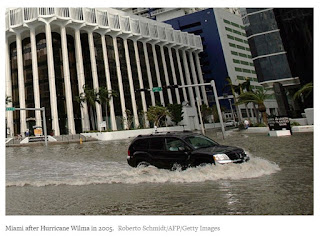Miami - Is It Doomed ????
MIAMI
Scientists are starting to suggest that, in the long run, much of South Florida cannot be saved and that policymakers should begin planning for how to best deal with a massive northward exodus in the coming decades, as some of the most iconic real estate on the continent begins to succumb to the sea.
"Sooner or later, this city, as you see it right now, won't be like this,1' says Henry Briceno, a water-quality researcher at Florida International University. "Miami and the whole of South Florida is not going to be like this any more. So we have to develop a way to plan and supply services in a changing scenario, and that's not easy. And then, sooner or later, we'll have to move. Most of the population will have to move."
Imagine a prohibition on fossil fuels, effective tomorrow. Every gas-guzzler off the road; every coal plant shuttered; every source of greenhouse-gas emissions brought under control.
Even then, by some estimates, the atmosphere would experience residual warming for another 30 years. That, in turn, would continue to heat the oceans for about another century. The warming ocean would melt the icepacks in Greenland and Antarctica. And, finally, those melting masses of ice would raise the sea level.
"We've missed the boat, so to speak, on stopping serious warming in a way so we can turn it around real quick,''says Harold Wanless, chair of the department of geological sciences at the University of Miami. "That's gone, we've warmed the ocean too much. So we're in for it now.1'
Very few people in Florida have spoken as passionately - or for so many years - as Prof. Wanless about what the irreversible mechanics of rising sea levels are likely to do to the southern half of this state. The son of a geologist, he has been talking to anyone who'll listen - community organizations, high schools, even the religious TV program The joo Club-since the early 19805.
Back then, projections estimated that sea levels would rise by about four feet by the end of the coming century. Today, that number is in the low to middle segment of U.S. government projections, which run as high as six feet
"That's going to eliminate living on all the barrier islands of the world," he says. "It's going to inundate major portions of the coastal delta in China, India, the U.S. and elsewhere. That's where a huge amount of agriculture is.1'
At six feet of sea-level rise, roughly half of Miami-Dade County will be under water. Given the impact such land loss would have on vital infrastructure, it may well render the area totally uninhabitable.
Few places are as geographically ill-equipped to deal with rising water as southern Florida. Not only is much of the land barely a few feet above sea level, it also sits on a bed of porous limestone and sand, making measures such as dikes far less effective.
MIAMI-2
A few years ago, dimatologist James Hansen suggested a sea-level rise of about 16 feet by 2100 - a number far higher than most other projections. The estimate was based in part on the idea of''amplifying feedbacks.1'For example, ice reflects almost all solar radiation, but open water absorbs it. So as an ice sheet melts, it has a reinforcing effect, increasing the melting rate. Several of those feedbacks had not been incorporated into other climate-change models. Accounting for them, Dr. Hansen argued, pushed the numbers up.
The projection was met with skepticism. To test it, Prof. Wanless recently decided to see if the melt rate in Greenland was consistent with Dr. Hansen's projections. Looking at satellite data, he found it was not - it was melting at an even faster rate.
Lee Gottlieb stands on a pristine beach a few kilometres north of Miami, observing his creation -a set of rolling dunes, anchored in place with sea oats. The grass is thin and shivers in the breeze. The structure is a sacrificial lamb; a major storm surge would likely destroy it. But it would still serve as a buffer, protecting the infrastructure farther inland. Mr. Gottlieb has been trying to convince municipalities and private developers to support the dune project. Some prospective partners have been receptive. Others declined, complaining, in one case, that if the oats grew too tall, they might ruin the ocean view from a condo's mezzanine-level pool.
"Do we really think [the sea oats project is] going to save the day? No,1' Mr. Gottlieb says. "But we need to bring people's attention to the issue. We can't afford to wait another lo years."
Exactly what South Florida will look like a decade from now is anyone's guess. It's impossible to predict whether another hurricane will devastate the area, or at what point insurance companies might balk at the risk.
Meanwhile, not everyone wants to discuss the notion of long-term evacuation. There's the prospect of plummeting home values, of the massive public and private costs. And there's a decidedly human factor: Some people don't want to leave the places they call home, come hell or high water.
"People think that everywhere we live has always been there, and that's Just not true,1' Prof. Wanless says. "Every community is so afraid of facing the reality that you have to move on some day, and honestly plan for it.




Comments
Post a Comment